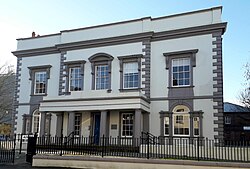Whitehaven Town Hall is a municipal building in Duke Street in Whitehaven, Cumbria, England. The building, which was the headquarters of Whitehaven Borough Council, is a Grade II listed building.[1]
| Whitehaven Town Hall | |
|---|---|
 Whitehaven Town Hall | |
| Location | Duke Street, Whitehaven |
| Coordinates | 54°32′53″N 3°35′04″W / 54.5480°N 3.5845°W |
| Built | 1710 |
| Architect | William Barnes |
| Architectural style(s) | Neoclassical style |
Listed Building – Grade II | |
| Official name | Town Hall |
| Designated | 13 September 1972 |
| Reference no. | 1086779 |
History
editThe building, which was originally designed as a family home for a local merchant, William Feryes, was built on land granted by Sir James Lowther at a cost of £2,400 and was completed in 1710.[2] The design involved a symmetrical main frontage with nine bays on three floors facing onto Duke Street and featured a cupola on the roof.[2] The house, which was known as "The Cupola", was surrounded by warehouses and was depicted in the foreground of the painting A Bird's-Eye View of Whitehaven by Matthias Read when he painted it in 1736.[2]
After Feryes died, the house passed to his wife, Mehetabel Feryes (née Gale), and was then passed down the Gale family until it was acquired by John Lewthwaite in 1796.[3] After Lewthwaite died, it passed to his daughter, Mary, who married a banker, Milham Hartley.[4] It then passed to Milham's son, John, and following his death, it was acquired, in 1847, by the Whitehaven Hematite Iron Company who sold it to the town of Whitehaven.[2]
The building was then substantially remodelled to a design by William Barnes to convert it into a municipal building in 1851.[5] The new design involved a symmetrical main frontage with five bays facing onto Duke Street; the central section of three bays, which slightly projected forward, featured a single-storey tetrastyle portico with Tuscan order columns supporting an entablature.[1] There were Venetian windows in the outer bays on the ground floor and sash windows flanked by brackets supporting cornices in all the bays on the first floor with the central sash window featuring a segmental pediment.[1] At roof level there was a cornice and a parapet.[1]
After significant population growth, largely associated with the growing importance of the town as a sea port, the area became a municipal borough in 1895.[6] The building continued to serve as the headquarters of the Whitehaven Borough Council for much of the 20th century but ceased to be the local seat of government after the new civic centre in Lowther Street was completed in 1953.[5][7] The town hall continued to be used for civic functions and the Duke of Edinburgh attended a reception at the town hall on 24 November 1955.[8]
After falling into a state of disrepair in the 1980s, the building was acquired, refurbished and brought back into use by British Nuclear Fuels Ltd (BNFL) who let it as a courthouse to HM Courts and Tribunals Service in 1996.[9] BNFL sold it to a West Cumbrian investor, while it was still in use as a courthouse, in 2005.[10] After HM Courts and Tribunals Service moved out of the building in 2010,[11] and following a further refurbishment, it was let to the American engineering design firm, AECOM, in 2017.[12]
See also
editReferences
edit- ^ a b c d Historic England. "Town Hall (1086779)". National Heritage List for England. Retrieved 19 May 2021.
- ^ a b c d "Duke Street, Whitehaven". Whitehaven and Western Lakeland. Retrieved 19 May 2021.
- ^ "The Feryes, Ferres, Ferise or Farish Family of St. Bees and Whitehaven". Retrieved 19 May 2021.
- ^ "Milham Hartley". Centre for the Study of the Legacies of British Slavery. Retrieved 19 May 2021.
- ^ a b "Whitehaven". Cumbria County History. Retrieved 19 May 2021.
- ^ "Whitehaven MB". Vision of Britain. Retrieved 19 May 2021.
- ^ "Principal elevation Whitehaven Civic Hall and Library". Cumbria Archives. 1952. Retrieved 19 May 2021.
- ^ "HRH The Duke of Edinburgh's visits to Cumbria". Cumbria County Council. Retrieved 19 May 2021.
- ^ "Cupola House/Duke Street/Whitehaven/Cumberland". Cumbria Archives. Retrieved 19 May 2021.
- ^ "Court sells for over £330,000". Whitehaven News. 10 November 2005. Retrieved 19 May 2021.
- ^ "Government publishes final list of courts set for closure". Local Government Lawyer. 15 December 2010. Retrieved 19 May 2021.
- ^ "Aecom's Whitehaven office under review". In Cumbria. 7 June 2019. Retrieved 19 May 2021.
